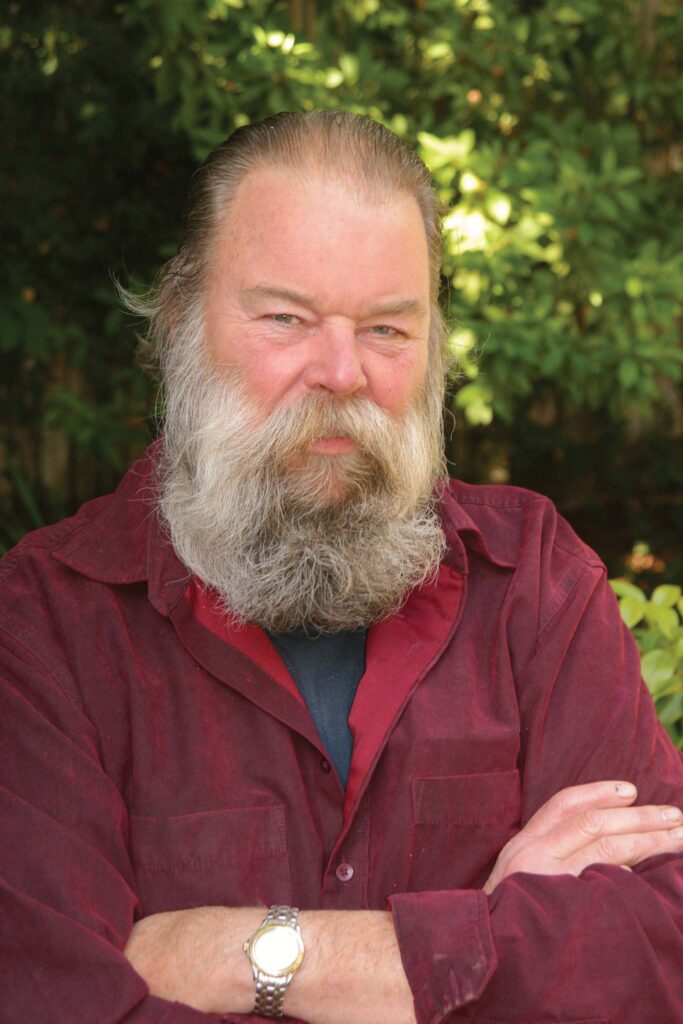
Multiple sources are reporting the sad news that Garry Knox Bennett, a giant in the furniture making world, has died. He was born in 1934 in Alameda, Calif. The following is excerpted from “The Difference Makers,” by Marc Adams (2019).
Garry Knox Bennett is an American icon in the field of woodworking. He studied painting and sculpture at the California College of Arts and Crafts and is a self-taught furniture maker living in Oakland, Calif. His trademark is the combined use of fine metalwork and woodworking. Garry’s work is in private collections as well as the Museum of Fine Arts, Boston; The Mint Museum in Charlotte, N.C.; the Museum of Arts and Design in New York City (formerly the American Craft Museum); the Mobile Museum of Art in Alabama; the Montreal Museum of Fine Arts; the Oakland Museum of California; the Racine Art Museum in Wisconsin; the San Francisco Museum of Modern Art; the Smithsonian American Art Museum; the Victoria and Albert Museum in London; and more.
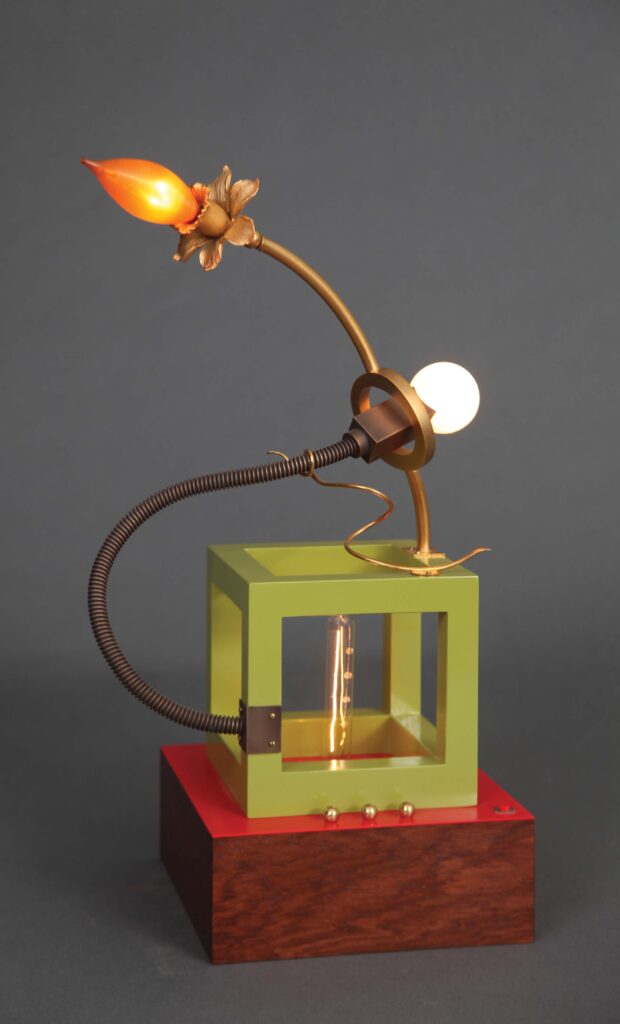
A major retrospective of Garry’s work was initiated at the Museum of Arts and Design in New York City (formerly the American Craft Museum) in January 2001, which included a showing at the Oakland Museum of California. The exhibition was documented with an extensive book on his work: “Made in Oakland: The Furniture of Garry Knox Bennett.” Garry has taught and lectured extensively in the U.S. as well as in Canada, Australia and the U.K. In 2004, he received the Award of Distinction from The Furniture Society and was honored as Fellow of the American Craft Council. In 2011, Garry received the James Renwick Alliance Master of the Medium award in Washington, D.C.
On the Professional Side
After leaving the California College of Arts and Craft in 1960 to pursue painting and welded-steel sculpture, Garry found work in the Bay Area making sculptural light fixtures for homes and commercial buildings. Work was sporadic, however, and commissions from his paintings, sculptures and art shows were not enough to ensure a consistent income for his growing family. Garry searched for an avenue that would allow for a base income to enable him to focus on his art.
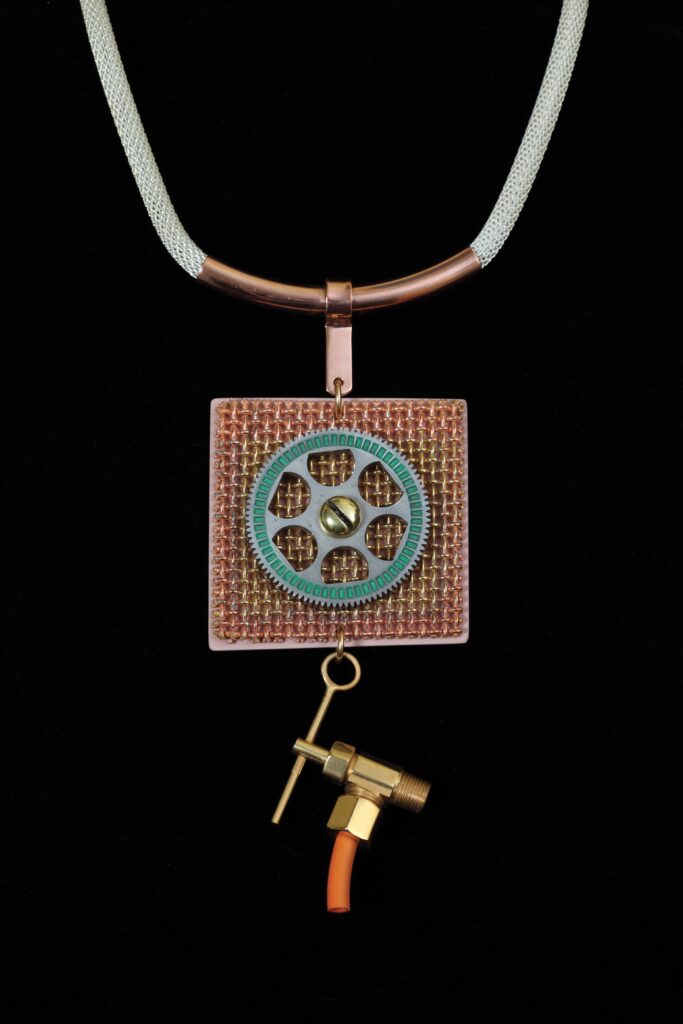
Garry and his lovely wife, Sylvia, had an opportunity to build a home and live in a rural setting on land owned by Garry’s ex-stepfather, a rice farmer in Lincoln, Calif. The plan was for this “rural living” to afford a modest livelihood as part-time property caretakers and part-time artist. On the outside it seemed an ideal way for Garry to grow in his work, but the reality was otherwise and they returned to the Bay Area after five years.
Still looking for that “thing” that would generate basic support, Garry discovered the next opportunity through friends who had a shop in Berkeley, Calif. They approached Garry about making some jewelry, primarily earrings. It was the 1960s and the beginning of San Francisco’s Haight-Ashbury “hippy” days – anything large and dangly with beads was hot! During this time, Garry designed and produced peace symbols, roach clips and assorted “hippy” accoutrements. His company, “Squirkenworks,” was started in 1965. Garry viewed himself as a commercial sculptor and artist who sold to both a wide counterculture market and an upscale clientele.
His choice of material was brass brazing-rod, which he had used in his sculpture. It was cheap and readily available. The work was a huge success and evolved into a major line of precious-metal jewelry, which was sold in stores across the U.S. Henri Bendel in New York City was a customer. The result was a stable income for many years, allowing Garry to retreat and focus on his personal work.When Richard Nixon outlawed drug paraphernalia in 1974, Squirkenworks ceased manufacturing, and the “Summer of Love” segued into the “Death of the Hippy.” An era was over. Garry, however, chose to expand the plating shop that he had set up for his production work and offer precious-metal plating to other manufacturers. The shop is still operating as Gold Seal Plating today.
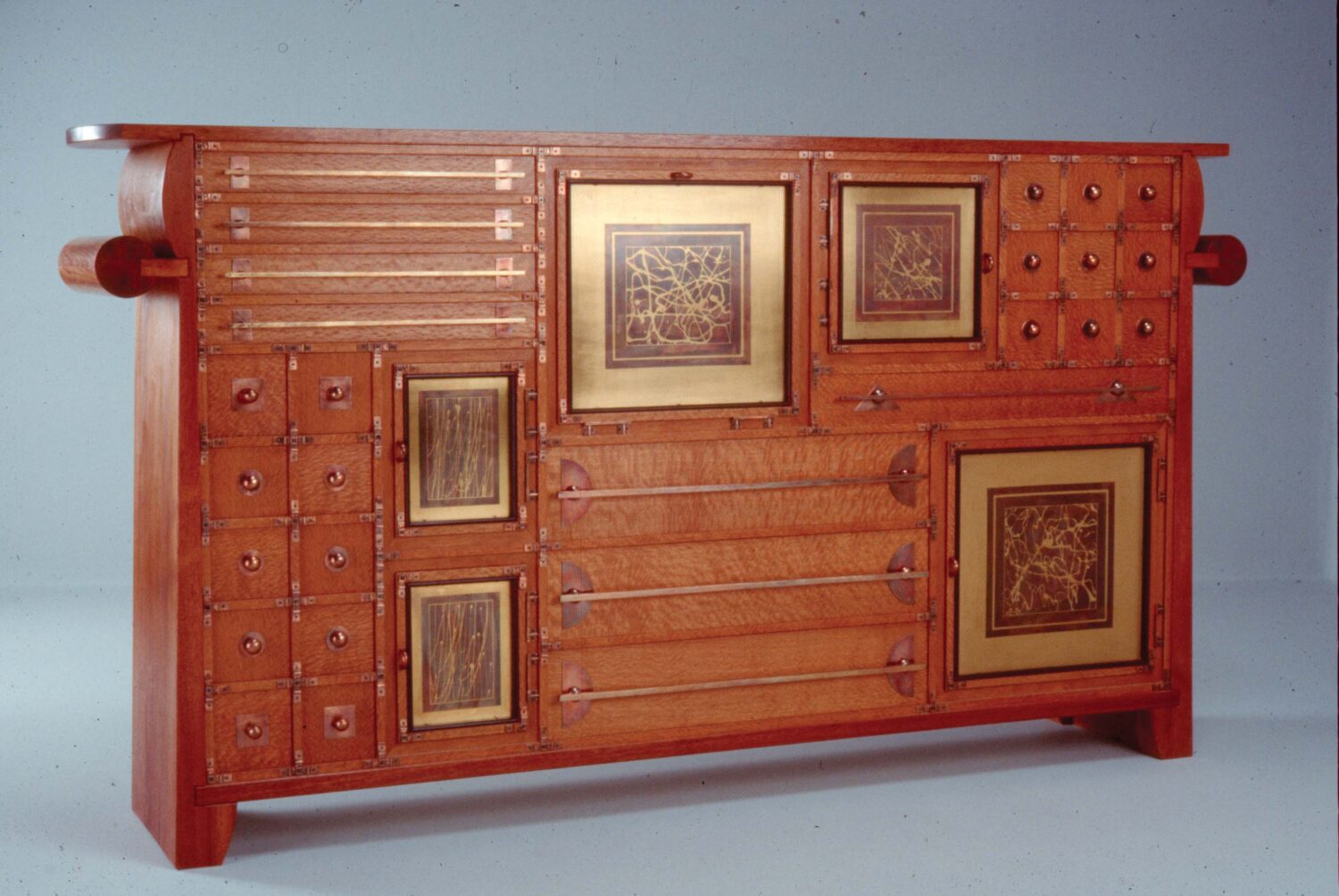
Garry’s move to functional work was possibly initiated by his early light fixtures. One of his commissions was a fixture that started at a front door entry and traversed the entire home, following the ceiling through the living room and ending in the dining room – illuminating one of Garry’s paintings that the client owned. Initially he worked exclusively with metal, which included a series of metal clocks. His first series of functional work, Cloud Clocks (all metal), was exhibited at Gump’s, then a world-renowned fine and decorative arts gallery in San Francisco.
He gradually moved toward some very primitive wooden casework. At first his only woodworking equipment was an old table saw that he used when he built his first house on his ex-stepfather’s farm. Garry found cabinets intriguing and started making some simple and, according to Garry, “very crude by woodworking standards” cabinets with drawers that often incorporated elaborate light fixtures attached to the casework.
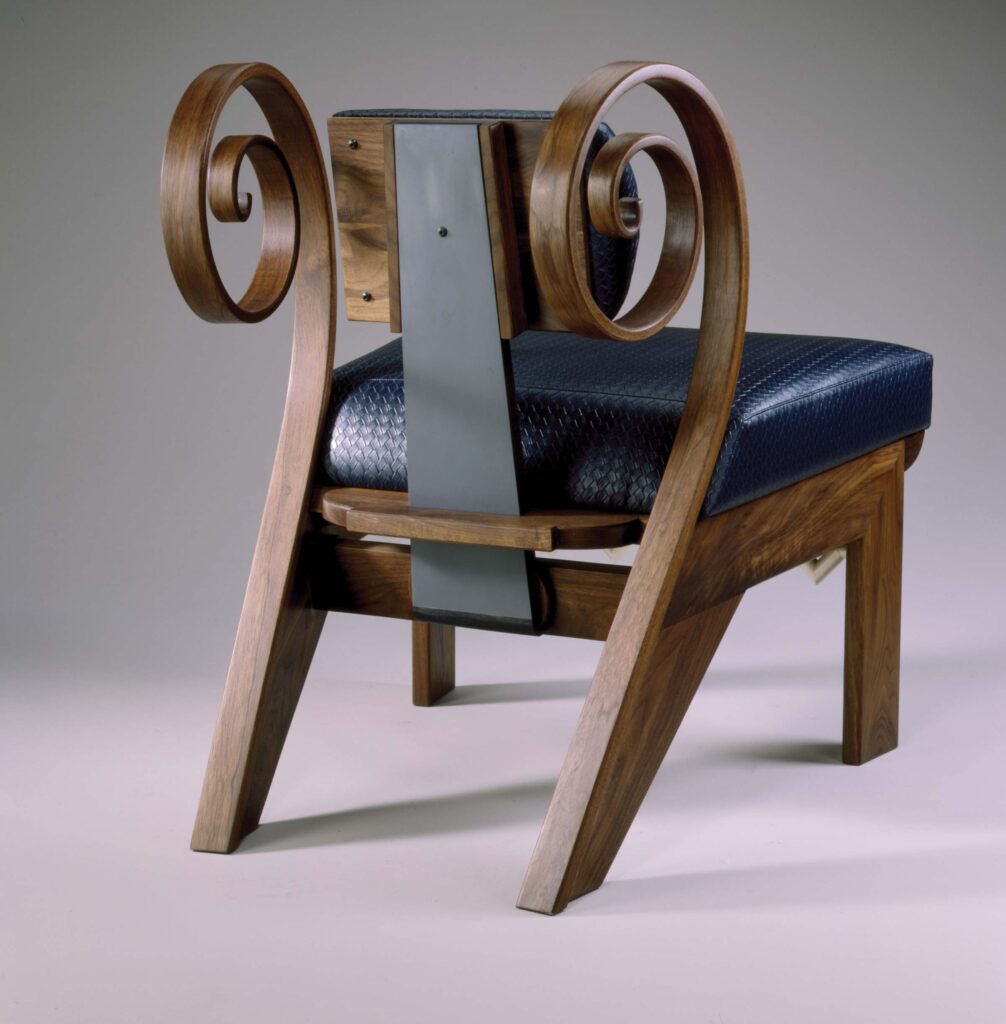
An old friend who had a gallery in San Francisco was about to open a new gallery for furniture and glass and asked whether Garry would be interested in exhibiting in a group furniture show. Although Garry didn’t consider himself a furniture maker, he was interested in being included. So he turned to a group of like-minded young furniture makers in his area to see what kind of work was being produced. Although the majority of work at the time was impressive, he noticed there seemed to be far more attention paid to intricate dovetails while overlooking some pretty basic design concepts. Most work lacked visual excitement, shape and color. The door was open for a California-style furniture earthquake.
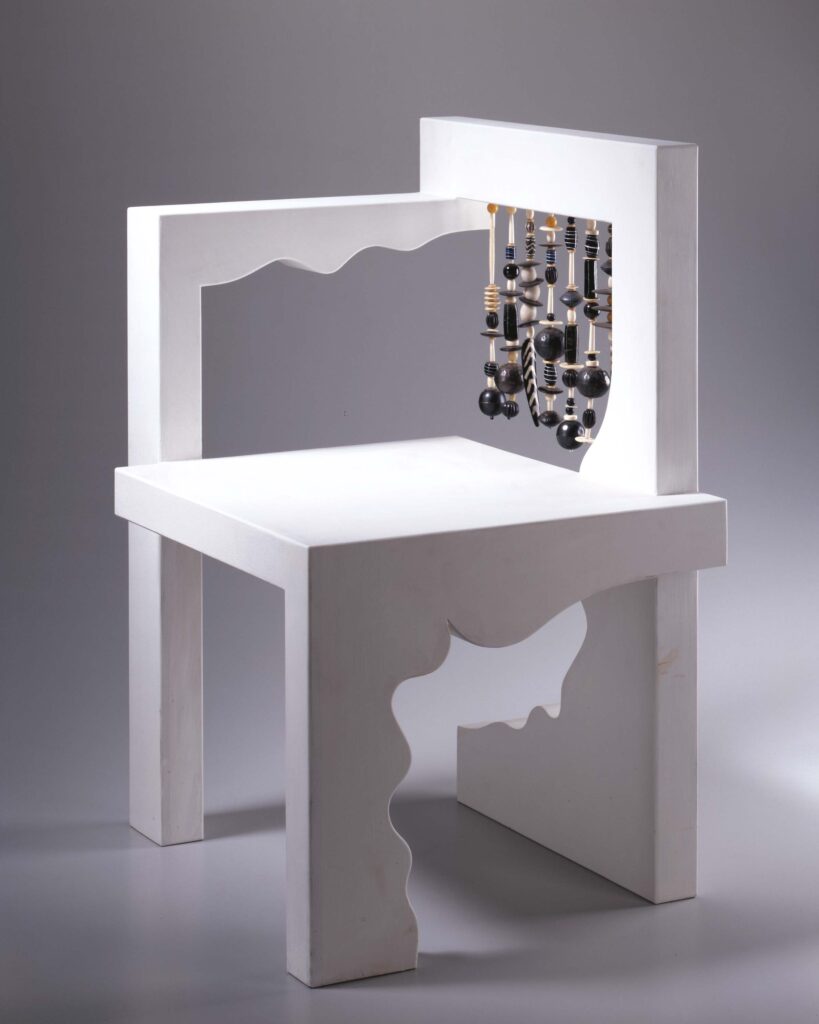
Noticing the extreme focus on joinery, fine wood and lots of dovetails by many of these makers, Garry decided to make a piece of furniture for this new gallery exhibition that was visually exciting. Garry said, “there is much more to making an interesting piece of furniture than just fancy wood and joinery.” He intentionally set out to show that an untrained person could execute reasonable joinery and make a special piece that can become more than the sum of its joints. His now-famous “Nail Cabinet” was born.
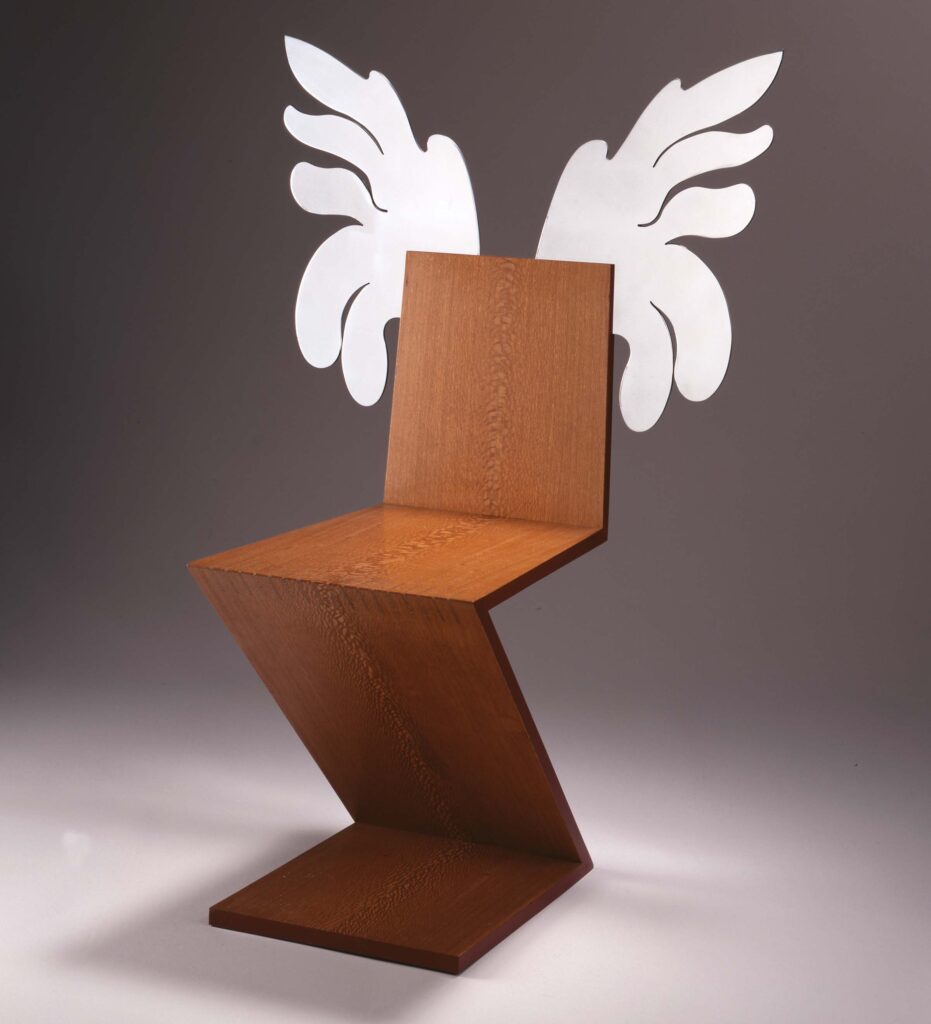
This piece was a reaction to the decree that “the wood is paramount.” For Garry, wood was one vehicle to an exciting visual outcome. Design, function and excitement were far more important to him than the fact that an exotic material was used. The “Nail Cabinet” was conceived as a statement. And, to be honest, Garry grossly underestimated the reaction in downtown San Francisco that it would generate. Many perceived it as an abomination and sacrilegious (to put it mildly). With the criticism came unexpected attention. The labels of renegade/Philistine etc., opened a door that Garry was ready to enter. From that point, Garry put painting and sculpture on the back burner and it was furniture full-speed ahead.

This little bit of notoriety enabled Garry to comfortably explore a divergent approach which he found to be exciting. After the “Nail Cabinet,” the public would not be shocked by what would follow. Coming from an art background, his base was composition, balance, design and visual excitement, all of which were missing from most of the furniture at the time. Garry moved beyond the “California roundover” (referencing the soft edges given to most of the work being done in the late 1970s on the west coast). He was able to produce quality work without the sophisticated skill and training of the east coast approach to furniture making.
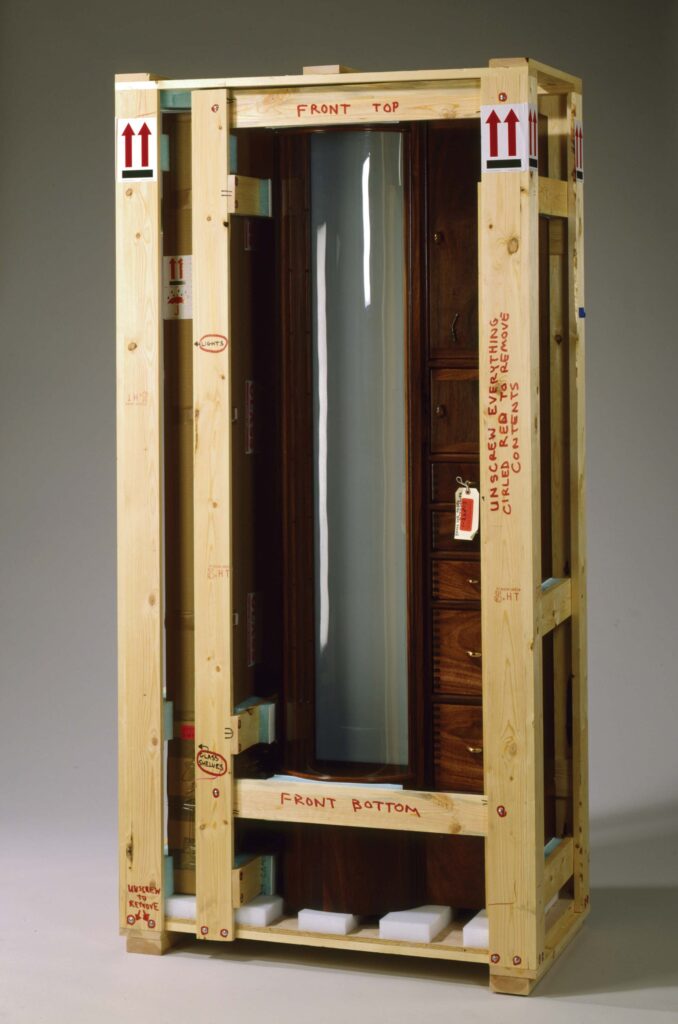
His life is unique in that his choices have been made by just following a thread that has allowed him to do exactly what he wants to do in his own fashion, which is not an easy task. Garry underplays the business of art, but it exists. It is the conscious act of embracing anything that will enable you to do what you wish in the manner you choose. He lives by a simple rule: Set up a challenge and then go for it; success or failure, the effort serves to expand one’s abilities.
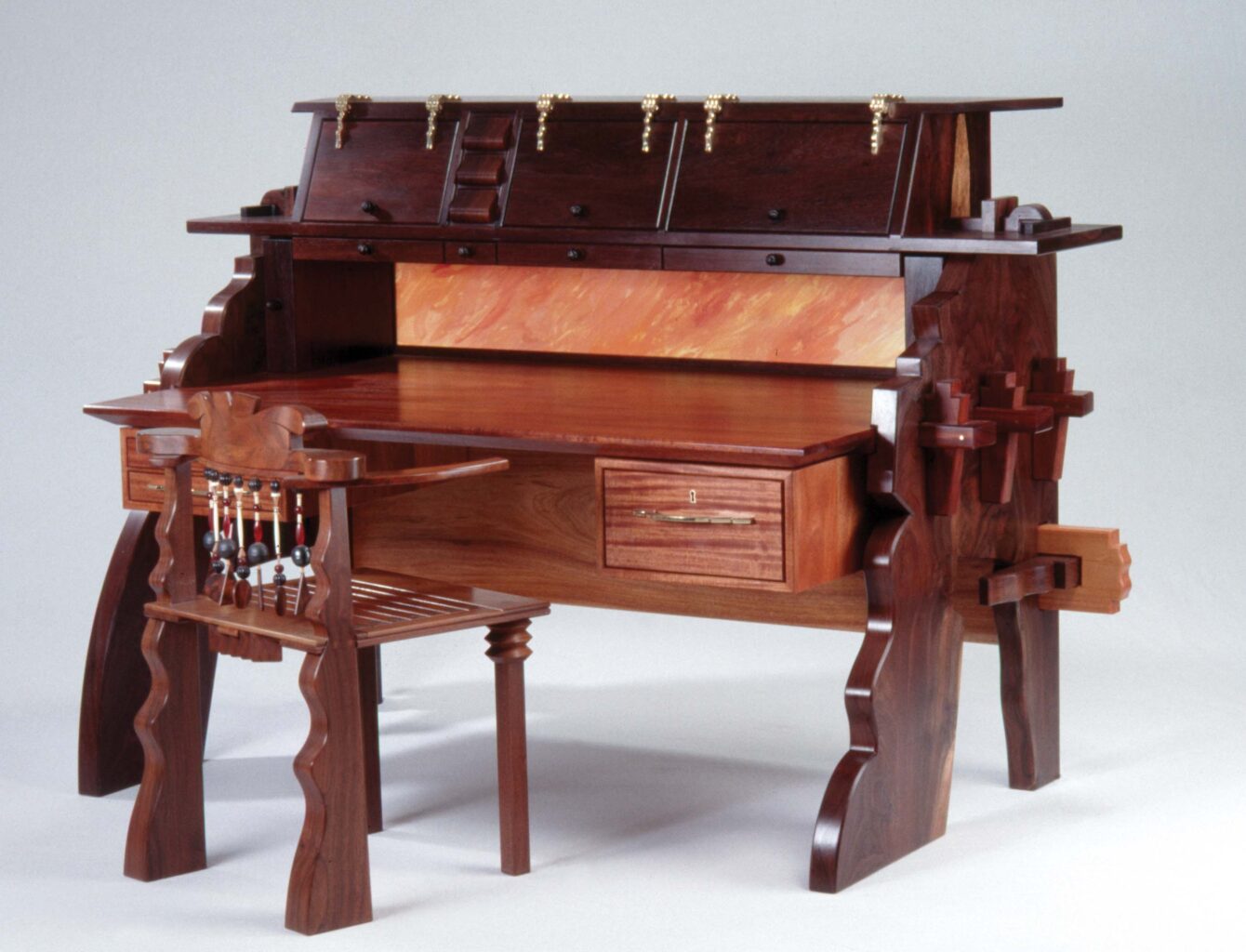
On the Personal Side
I first contacted Garry about teaching at MASW in the late 1990s, but it wasn’t until the summer of 2005 that the dream became a reality. Garry agreed to do a workshop where students, along with Garry, would make a table that would be auctioned with proceeds split 50-50 between The Furniture Society and the Roger Cliffe Memorial Foundation. Made from walnut, the table featured a breadboard top with massive through-mortise-and-tenon joinery, which is typical of the GKB style. When completed, Garry and each student signed the underneath of the tabletop. The table sold for more than $10,000….

Garry likes to enjoy life to the fullest. He is witty, artful, funny, clever and maybe every now and then a little sinful. Seth Stem, professor at the Rhode Island School of Design (RISD), once told me that he invited Garry to be a guest lecturer at RISD. Somehow the story goes that Garry’s flight arrived very late and by the time he got to Seth’s house it was the middle of the night. Pounding on Seth’s door, Garry yelled, “Where’s the beer?” I’m not quite sure if that story is true (it might have been something harder than beer), but Seth warned me that having Garry teach at MASW might be an experience. Seth knows that I’m a straight shooter. I don’t drink, smoke, cuss, gamble, use drugs or any of that “sinful” stuff, and when Seth heard I had invited Garry to teach at MASW, he thought he better give me a heads-up.

Although I had talked to Garry often, I never will forget the phone conversation we had before his first trip to MASW. The concern in his voice bordered somewhere between terrified and repentant. “Marc, before I come to Indiana I have just one question. Now Indiana, isn’t that one of those Bible Belt States?” He promised me that he would be on his best behavior. As it turns out, Garry was a true gentleman and was one of the most gracious, polite and wonderful instructors I have ever had. At the end of his first workshop I will never forget saying goodbye in my driveway. He took me to the side and told me what it meant to him to be a part of our program, then gave me a big brotherly hug and drove away – straight to the bar.


Thanks so much for sharing this. He was loved by many.
That’s too bad, when I was in furn school in the late 80’s early 90’s he along with Wendell C, Judy K McKie were all inspirations to us kids in the art furniture world. I especially remember the nail cabinet, just loved that he built this beautiful well crafted cabinet the pit a nail in it – what a statement!
That’s very sad. He was a giant. An influencer before the term was coined. And the man knew his crates.
Tis a sad day indeed, he will be sorely missed, God’s speed old friend.
Many years ago I was a woodworker in the Bay Area – Garry was a beloved living legend in our woodworking world. To my delight, he helped me on a project which required making two stout, heavy Koa columns that were mounted on a bar in Hawaii. My hero!
That Tansu chest and owl desk are insane! That is some incredible artistic and woodworking talent. RIP Garry.
Saw a documentary about him, he said he never used his middle name and didn’t know why others insisted on doing so.
I’ll bet his Mom used all three names, when she was angry.
We was such an inspiration to me and very generous. Each time I would visit he give me something. “I’ve been making lamps, which one do you want?” He’d send me stuff without letting me know.
I have admired this mans work for all my 45 years of woodworking.Total creativity in a field that is hard to be original.Boy I would of loved to hang out with him and will regret not having met him in person.
So sad to hear. Such an Icon. Thanks for sharing about his life and craftsmanship.
I like his eye for furniture. Reminds me of some of my crazy ideas.
I first learned about him from the Craft in America series. As a high school woodworking teacher I have shown many students his work. The Nail Cabinet continues to evoke a wide variety of strong response. I wish I could have met him. He continues to inspire.
Not just sad news, but shocking bad news. He was always my favorite cousin. I looked up to him figuratively and literally. Even though I was just a little pest, he always had some time for me. Not a lot but barely enough
My favorite image of him was coming back through the rice fields. We had been out pheasant hunting. It was close to sunset. All I could see was his giant silhouette against the sun, holding his long shotgun by the barrel over his shoulder. He was so contented. I had cleaned his pheasant. I would do anything for him
He sure did love his wife. If you know her, you know why. They were the perfect pair